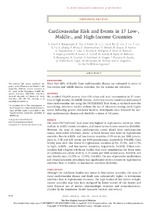| dc.contributor.author | Yusuf, Salim | |
| dc.contributor.author | Rangarajan, Sumathy | |
| dc.contributor.author | Teo, Koon | |
| dc.contributor.author | Kelishadi, R. | |
| dc.date.accessioned | 2016-10-12T15:07:47Z | |
| dc.date.available | 2016-10-12T15:07:47Z | |
| dc.date.issued | 2014 | |
| dc.identifier.citation | Yusuf, S. et al. (2014). Cardiovascular risk and events in 17 low-, middle-, and high-income countries. New England Journal of Medicne, 371: 818-27 | |
| dc.identifier.issn | 0028-4793 | |
| dc.identifier.uri | http://hdl.handle.net/10566/2447 | |
| dc.identifier.uri | http://dx.doi.org/10.1056/NEJMoa1311890 | |
| dc.description.abstract | BACKGROUND:
More than 80% of deaths from cardiovascular disease are estimated to occur in
low-income and middle-income countries, but the reasons are unknown.
METHODS:
We enrolled 156,424 persons from 628 urban and rural communities in 17 countries
(3 high-income, 10 middle-income, and 4 low-income countries) and assessed
their cardiovascular risk using the INTERHEART Risk Score, a validated score for
quantifying risk-factor burden without the use of laboratory testing (with higher
scores indicating greater risk-factor burden). Participants were followed for incident
cardiovascular disease and death for a mean of 4.1 years.
RESULTS:
The mean INTERHEART Risk Score was highest in high-income countries, intermediate
in middle-income countries, and lowest in low-income countries (P<0.001).
However, the rates of major cardiovascular events (death from cardiovascular
causes, myocardial infarction, stroke, or heart failure) were lower in high-income
countries than in middle- and low-income countries (3.99 events per 1000 personyears
vs. 5.38 and 6.43 events per 1000 person-years, respectively; P<0.001). Case
fatality rates were also lowest in high-income countries (6.5%, 15.9%, and 17.3%
in high-, middle-, and low-income countries, respectively; P = 0.01). Urban communities
had a higher risk-factor burden than rural communities but lower rates
of cardiovascular events (4.83 vs. 6.25 events per 1000 person-years, P<0.001) and
case fatality rates (13.52% vs. 17.25%, P<0.001). The use of preventive medications
and revascularization procedures was significantly more common in high-income
countries than in middle- or low-income countries (P<0.001).
CONCLUSIONS:
Although the risk-factor burden was lowest in low-income countries, the rates of
major cardiovascular disease and death were substantially higher in low-income
countries than in high-income countries. The high burden of risk factors in highincome
countries may have been mitigated by better control of risk factors and
more frequent use of proven pharmacologic therapies and revascularization.
(Funded by the Population Health Research Institute and others.) | en_US |
| dc.language.iso | en | en_US |
| dc.publisher | Massachusetts Medical Society | |
| dc.rights | Copyright Massachusetts Medical Society | |
| dc.source.uri | http://dx.doi.org/10.1056/NEJMoa1311890 | |
| dc.subject | Cardiovascular disease | en_US |
| dc.subject | Prospective Urban Rural Epidemiologic (PURE) cohort | en_US |
| dc.subject | High-income countries | en_US |
| dc.subject | Middle-income countries | en_US |
| dc.subject | Low-income countries | en_US |
| dc.title | Cardiovascular risk and events in 17 low-,
middle-, and high-income countries | en_US |
| dc.type | Article | en_US |
| dc.privacy.showsubmitter | FALSE | |
| dc.status.ispeerreviewed | TRUE | |
| dc.description.accreditation | ISI | en_US |

